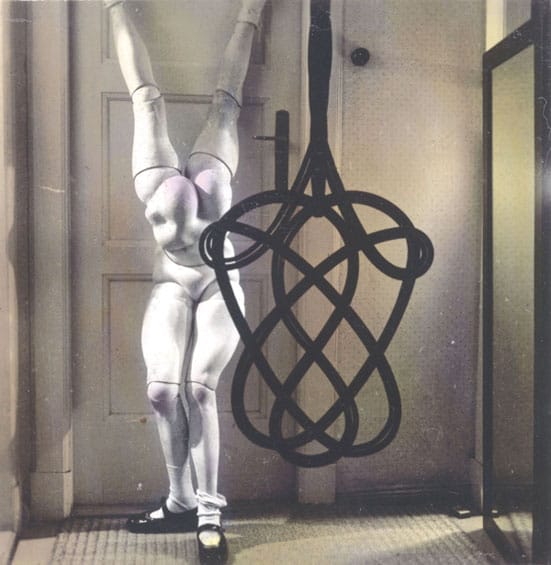20th September 2006 — 19th November 2006
This is the first comprehensive
UK retrospective of Bellmer’s
work and contains 150 photographs,
drawings, and objects. At its core
lies Bellmer’s doll series.
With the rise of the Nazi Party
in 1933, Bellmer withdrew from
any ‘socially useful activity’ that
would contribute to the economy
of the fascist state. Instead he
created a life-sized female doll
of papier-mâché and
plaster moulded over a wood and
metal skeleton, whose body could
be assembled like a machine. Bellmer
presented his doll acting out sadomasochistic
scenarios in a series of black
and white photographs. This work
was an attack on the promotion
of an idealised Aryan race by the
Nazis. In one photograph, the blurred
and ghostly figure of Bellmer accompanies
the doll, who wears a beret, head
coyly turned away, her sock falls
down her stick leg like an amputee
school girl. This artificial being
became a fetish object, a repository
for repressed desires. Violence
is inherent in these brutally cropped
images, she lies with legs spread,
silent, abused, pathetic. She is
an uncanny creature escaped from
a fairytale, an anatomical museum,
a nightmare. Naked beneath her
coat, with the starved body of
a prisoner of war or a trafficked
woman, she is palpably vulnerable. Cornered
against a wall, she looks over
her shoulder, with a sexual invitation,
bald head rhyming with naked rear.
The second doll, made in 1935,
is a chubby exquisite corpse with
swivelling ball joints and two
pairs of legs. Her tangled body
parts form increasingly abstract
assemblages. In one image
the doll lies as if fallen from
a great height, a jumble of flesh,
limbs at sickening angles. In others,
her body is a disturbing mess of
scrambled spherical body parts:
arm sockets, head, breasts, leg
joints, buttocks, eye balls, navel,
torso, stomach, knees, anus, exaggerated
pudenda. All these punning, interchangeable
elements are accessorised with
signifiers of childhood; blond
curls, a coquettish hair bow, white
ankle socks and patent shoes. The
black and white images are tinted
with sickly yellow and pink flesh
tones. Two pairs of conjoined legs,
wearing socks and shoes, lean against
a tree. The doll collapses seductively
at the bottom of a staircase, her
leg tied together with string.
Bellmer said: ‘If the origin
of my work is scandalous, it is
because, for me, the world is a
scandal.
Declared ‘degenerate’ by
the Nazi party, Bellmer left for
France in 1938. He met the Surrealists
and was interred with Max Ernst
during war. In his later career
Bellmer produced intricate drawings
informed by Freud, Charcot and
de Sade, whose flouting of social
moral norms and opposition to bourgeois
world he admired. In the 1950s
he photographed the torso of his
partner, artist Unica Zürn
bound tightly with string, like
a joint of meat, an abstract image
of the frailty of human flesh.
30 years after his death, Bellmer
remains a marginal figure and his
work retains its intensity and
power to shock. His influence can
be traced in much contemporary
work, the Chapman Brothers being
the most obvious example. Bellmer’s
work is displayed alongside uninteresting
drawings by Pierre Klossowski,
and works by his Surrealist contemporaries,
including Claude Cahun, Brassai,
Dora Maar, Leonor Fini, Duchamp
and Man Ray. These provide an excellent
context for Bellmer’s work
as he shared the Surrealists’ obsession
with Eros, death, the unconscious
and the uncanny.
AMG
Whitechapel
80-82 Whitechapel High Street
London E1 7QX
http://www.whitechapel.org
Open
Wednesday-Sunday, 11am-6pm

Hans Bellmer La Poupée (The Doll) for maquette for 'Les Jeux de la Poupée' (The Doll's Games), 1938 Courtesy of Whitechapel Art Gallery